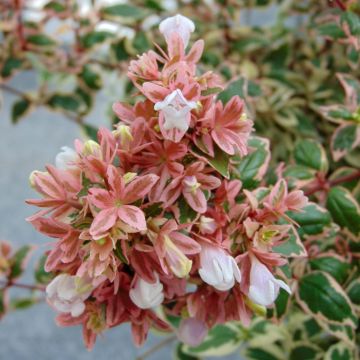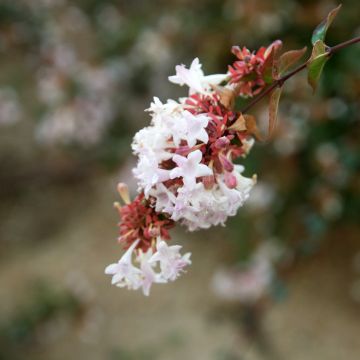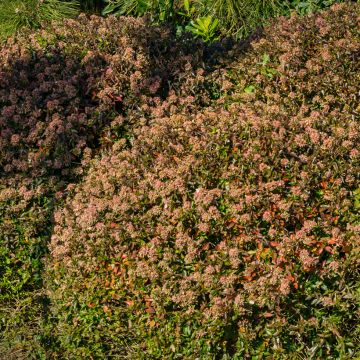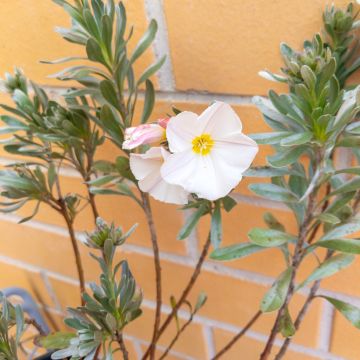

Abelia grandiflora Prostrata
Abelia grandiflora Prostrata
Abelia x grandiflora Prostrata
Glossy Abelia
This item cannot be shipped to the selected country
Delivery charge from €5.90
Delivery charge from €5.90
More information
Schedule delivery date,
and select date in basket
This plant carries a 24 months recovery warranty
More information
We guarantee the quality of our plants for a full growing cycle, and will replace at our expense any plant that fails to recover under normal climatic and planting conditions.
From €5.90 for pickup delivery and €6.90 for home delivery
Express home delivery from €8.90.
From €5.90 for pickup delivery and €6.90 for home delivery
Express home delivery from €8.90.

Does this plant fit my garden?
Set up your Plantfit profile →
Description
Abelia x grandiflora 'Prostrata' is a compact and prostrate form of abelia with large flowers. This specific feature makes it a beautiful ground cover bush, especially since it offers a particularly long and pleasantly fragrant summer flowering. Its small flowers, barely pinkish white, bloom in large numbers for almost 4 months. They look beautiful against the shiny dark green foliage that persists throughout the year in not too cold climates. Very easy to cultivate, hardy and drought-resistant, this unique and charming variety deserves a home in any garden.
Abelia x grandiflora is a bush from the Caprifoliaceae family. This hybrid is the result of cross-breeding between Abelia chinensis, native to temperate China, and A. uniflora, originating from eastern China. 'Prostrata' is mainly distinguished by its very low habit. This vigorous and hardy bush produces arching branches, almost pendulous. Wider than tall, with a moderately slow to slow growth, it will reach an average height of 80 cm (31.5 in) and a spread of 1.25 m (4.1 ft). Abelia offers a long fragrant flowering that lasts throughout the summer, from July to October, when few bushes are in bloom. Its countless small funnel-shaped corollas, barely pinkish white, are grouped in terminal panicles. These flowers, 2 cm (0.8 in) long, are composed of 2 to 5 sepals. As the flowers fade, they give way to beautiful calyxes composed of rusty-coloured bracts, which are very decorative on the autumn foliage. The formed fruits are called achenes, and contain only one seed. The arching branches bear glossy semi-evergreen foliage that is dark green until summer. The leaves, 5 cm (2 in) long, are ovate and more or less dentate. With the first cool nights, they take on a purplish hue, tinged with dark pink, and persist for a long time on the branches.
Hardy up to -17° C (1.4° F), not demanding on the nature of the soil and drought-resistant, it only requires light pruning at the end of winter. Abelia grandiflora 'Prostrata' can be placed both in groups with other low bushes, in flower beds or even in small free or pruned hedges. As a companion in a large ground cover and evergreen flower bed, one can choose Ceanothus prostratus, Buddleia 'Miss Ruby', Escallonia 'Red Carpet' or even Nandina 'Fire Power' for example. It is also suitable for cultivation in very large pots.
Report an error about the product description
Abelia grandiflora Prostrata in pictures
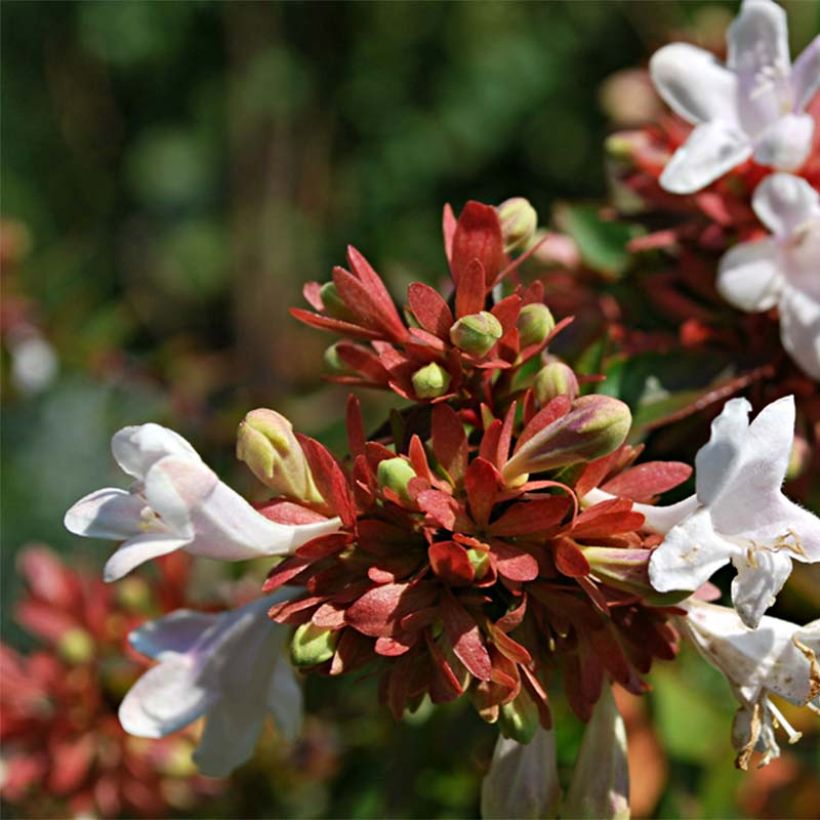



Plant habit
Flowering
Foliage
Botanical data
Abelia
x grandiflora
Prostrata
Caprifoliaceae
Glossy Abelia
Cultivar or hybrid
Other Abelia
Planting and care
Abelia x grandiflora 'Prostrata' thrives in sunny or partially shaded positions. Plant it in spring or early autumn in light, rather fertile, and well-drained soil. The ideal is to plant it in a balanced mixture of compost and garden soil. Easy to grow, it requires little maintenance. This plant is resistant to cold, salt spray, and wind, but protect it from heavy frosts and cold, dry winds when it is young in winter. Between February and April, before new growth begins, prune the diseased or dead wood and keep only the vigorous branches to maintain the bush's compact habit. It is not susceptible to parasites or predators.
Planting period
Intended location
Care
-
, onOrder confirmed
Reply from on Promesse de fleurs
Evergreen shrubs
Haven't found what you were looking for?
Hardiness is the lowest winter temperature a plant can endure without suffering serious damage or even dying. However, hardiness is affected by location (a sheltered area, such as a patio), protection (winter cover) and soil type (hardiness is improved by well-drained soil).

Photo Sharing Terms & Conditions
In order to encourage gardeners to interact and share their experiences, Promesse de fleurs offers various media enabling content to be uploaded onto its Site - in particular via the ‘Photo sharing’ module.
The User agrees to refrain from:
- Posting any content that is illegal, prejudicial, insulting, racist, inciteful to hatred, revisionist, contrary to public decency, that infringes on privacy or on the privacy rights of third parties, in particular the publicity rights of persons and goods, intellectual property rights, or the right to privacy.
- Submitting content on behalf of a third party;
- Impersonate the identity of a third party and/or publish any personal information about a third party;
In general, the User undertakes to refrain from any unethical behaviour.
All Content (in particular text, comments, files, images, photos, videos, creative works, etc.), which may be subject to property or intellectual property rights, image or other private rights, shall remain the property of the User, subject to the limited rights granted by the terms of the licence granted by Promesse de fleurs as stated below. Users are at liberty to publish or not to publish such Content on the Site, notably via the ‘Photo Sharing’ facility, and accept that this Content shall be made public and freely accessible, notably on the Internet.
Users further acknowledge, undertake to have ,and guarantee that they hold all necessary rights and permissions to publish such material on the Site, in particular with regard to the legislation in force pertaining to any privacy, property, intellectual property, image, or contractual rights, or rights of any other nature. By publishing such Content on the Site, Users acknowledge accepting full liability as publishers of the Content within the meaning of the law, and grant Promesse de fleurs, free of charge, an inclusive, worldwide licence for the said Content for the entire duration of its publication, including all reproduction, representation, up/downloading, displaying, performing, transmission, and storage rights.
Users also grant permission for their name to be linked to the Content and accept that this link may not always be made available.
By engaging in posting material, Users consent to their Content becoming automatically accessible on the Internet, in particular on other sites and/or blogs and/or web pages of the Promesse de fleurs site, including in particular social pages and the Promesse de fleurs catalogue.
Users may secure the removal of entrusted content free of charge by issuing a simple request via our contact form.
The flowering period indicated on our website applies to countries and regions located in USDA zone 8 (France, the United Kingdom, Ireland, the Netherlands, etc.)
It will vary according to where you live:
- In zones 9 to 10 (Italy, Spain, Greece, etc.), flowering will occur about 2 to 4 weeks earlier.
- In zones 6 to 7 (Germany, Poland, Slovenia, and lower mountainous regions), flowering will be delayed by 2 to 3 weeks.
- In zone 5 (Central Europe, Scandinavia), blooming will be delayed by 3 to 5 weeks.
In temperate climates, pruning of spring-flowering shrubs (forsythia, spireas, etc.) should be done just after flowering.
Pruning of summer-flowering shrubs (Indian Lilac, Perovskia, etc.) can be done in winter or spring.
In cold regions as well as with frost-sensitive plants, avoid pruning too early when severe frosts may still occur.
The planting period indicated on our website applies to countries and regions located in USDA zone 8 (France, United Kingdom, Ireland, Netherlands).
It will vary according to where you live:
- In Mediterranean zones (Marseille, Madrid, Milan, etc.), autumn and winter are the best planting periods.
- In continental zones (Strasbourg, Munich, Vienna, etc.), delay planting by 2 to 3 weeks in spring and bring it forward by 2 to 4 weeks in autumn.
- In mountainous regions (the Alps, Pyrenees, Carpathians, etc.), it is best to plant in late spring (May-June) or late summer (August-September).
The harvesting period indicated on our website applies to countries and regions in USDA zone 8 (France, England, Ireland, the Netherlands).
In colder areas (Scandinavia, Poland, Austria...) fruit and vegetable harvests are likely to be delayed by 3-4 weeks.
In warmer areas (Italy, Spain, Greece, etc.), harvesting will probably take place earlier, depending on weather conditions.
The sowing periods indicated on our website apply to countries and regions within USDA Zone 8 (France, UK, Ireland, Netherlands).
In colder areas (Scandinavia, Poland, Austria...), delay any outdoor sowing by 3-4 weeks, or sow under glass.
In warmer climes (Italy, Spain, Greece, etc.), bring outdoor sowing forward by a few weeks.

































